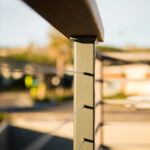Stainless Steel is Stronger Than Aluminum
Do you have questions about the superiority comparison between Aluminum vs. Stainless steel? Which one of these versatile metal is right for your project? Arguments from camps for both metals are as old as fabrication itself; especially for manufacturers that utilize either or for production of their products. Our comparison in this post relates directly to railing systems and components- primarily posts and top railing sections. What are the best material choices for durability and aesthetics when it comes to deck railings?
The short answer is that despite the lightweight versatility of aluminum, it does not compare to stainless steel when used as a structural railing member. A simple field strength comparison between railing posts will require a larger cross section of aluminum in order to compete with the stainless steel post member. In addition, a more robust weld is required to resist the same amount of force between the two.
A BIT OF INFORMATION ABOUT BOTH METALS:
ALUMINUM- Lightweight, versatile, and corrosion resistant. Conductivity of this metal is excellent. although this is not desired for railing applications. Easier to shape and form than stainless steel; once again not particularly desirable for railing unless bending or shaping is desired.
STAINLESS STEEL- Well known for strength and durability and superior in this type of comparison. Superior corrosion resistance; coating takes this metal even further. Heat resistant, hygienic , and preferred for structural integrity.
T316 Stainless Steel is More Corrosion Resistant
When considering corrosion resistance both of these metals are highly effective at resisting corrosion. Stainless steel has an edge in chemical and moist environments. Another consideration when either material is combined with stainless steel cables – it is preferable to have similar metals touching one another; especially when salt is introduced. Dissimilar metals will react together when chemicals, salt, and/or moisture is introduced between the two metals accelerating oxidation, or even corrosion. Visible signs of this are staining, pitting, and or oxidation.
Cost Comparison of Stainless Steel vs. Aluminum Alloy
If there is any significant cost difference between the two metals it likely relates more to machining and/or freight cost than the metal itself. Once again our comparison is in regards to finding the superior material for fencing and railing applications. Mass produced fencing and off the shelf railing kits can be less expensive than a welded stainless steel railing kit. That is likely the draw to these products; and the only real example of superiority for Aluminum railings- they can be mass produced and shipped at a lower cost. “Cookie Cutter” is a term often used for off the shelf pre packaged products; these can and do function well in certain situations. Timelines are definitely faster with off the shelf availability. Custom fabricated railing systems with curves, angles, high load bearing requirements, and extreme environmental conditions are likely not suitable cookie cutter applications.
Why Choose Aluminum vs. Stainless Steel !?
Unless you have a custom consideration that requires the properties that aluminum excels at ; we can’t see a reason to choose an aluminum railing system over a stainless steel comparable. In addition to all the positive attributes mentioned earlier in this post; stainless steel is also highly recycled and done without degradation of the metal. Stainless and aluminum are both very “green” options for sustainability. Although there may be a higher upfront production load or cost with stainless; the long term durability likely creates a lower overall footprint when comparing two like railing members over their lifespans.
Which Metal Railing is Easier to DIY?
Our preferred contractors at San Diego Cable Railings have installed hundreds of stainless steel and aluminum systems all over California. A large majority of our projects are coastal. Believe it or not the stainless steel kits can be easier to install due to the need for less components. The added strength of stainless for carrying tension loads and heavy glass panels can make certain operations easeier for the installer.
Although an aluminum kit will be lighter, it will likely use the same cable assemblies and require a bit more hardware to protect penetrations. A larger cross section (2.25″ O.D. vs. 2″ O.D) of tube will be required to acheive similar load resistance on two like railing posts.
If you have questions about aluminum and stainless steel railing systems feel free to give us a call or visit the QUOTE REQUEST form for a free estimate on our popular stainless cable railing and glass railing systems.






